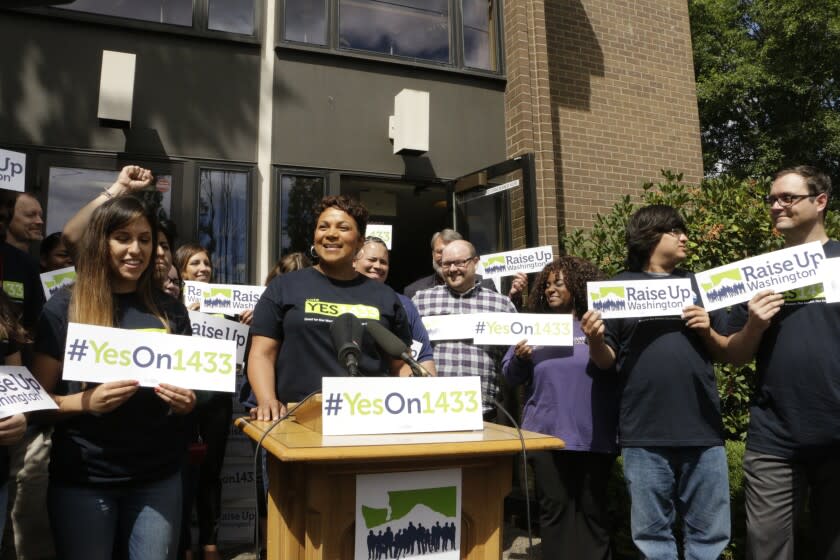Op-Ed: The U.S. needs paid sick leave. Here's how to get it right

Paid leave has emerged from the pandemic as a popular policy, frequently invoked as one route to move America forward from COVID-19 and its brutal impact on workforces nationwide.
The U.S. is the only wealthy nation in the world that does not guarantee workers paid time off when they are sick. Instead, we have a patchwork of state and local paid sick leave laws that leave big gaps in coverage for workers. If the country passes a national sick leave policy to make existing state-by-state protections more universal, the hope is that workers will get necessary protections for their health, protecting their workplaces at the same time.
If only it were that simple. Americans do need a national paid sick leave policy. But we also need to recognize that this policy will fail unless it’s designed to improve on what even the best state policies currently offer.
The lack of sick leave is an economic inequality problem. While large percentages of high-wage workers are paid for sick days, that’s true for only about 30% of the lowest-paid workers, per a Pew Research Center report. Around 33.6 million Americans, mostly within low-income brackets, don’t have any paid sick time off.
It's also a public health problem. Without paid sick leave, workers in low-wage, essential and frontline industries often have no choice but to work sick. As a result, they risk infecting co-workers, clients, patients and the public at large — as has devastatingly happened in understaffed nursing homes that relied on COVID-infected employees.
On the other hand, when workers have access to paid sick leave, it substantially limits outbreaks from the flu and food-borne illnesses. The Families First Coronavirus Relief Act — Congress’ temporary paid sick leave law — helped flatten the curve for COVID-19 infections.
The data clearly supports universal paid sick leave. That may help explain why President Biden name-checked paid leave in this year’s State of the Union and why it was among the most fought-for policies in his now stalled Build Back Better legislation.
But clamoring for a national paid sick leave law and creating one that works are two very different things. Rather than simply replicating existing state and local paid sick leave policies in a federal proposal — which Congress has tried and failed to do via the Healthy Families Act — we need to focus on the vulnerable workers routinely left out of sick leave policy.
The main problem with most state and local paid sick leave laws is that they depend on workers filing complaints with the appropriate government agency or court if employers flout the law. But much of America’s low-wage workforce is too scared of employer retaliation to file complaints, especially not at the risk of losing their jobs. Workers who are migrants or immigrants, or who live with undocumented family members, additionally fear immigration detention and deportation if they complain.
As a result, many low-wage workers do not get paid sick time even in places with robust laws. A survey of essential workers in Massachusetts — a state that guarantees paid sick leave — found that early in the pandemic, 17% of workers didn’t get paid sick time, especially if they were low-wage or Latino.
Beyond placing the burden on workers to speak out when their rights are violated, these laws also place the entire burden of paying out sick time on individual employers. Many are cash-strapped or do not see the benefits of paid sick leave. Research, in fact, suggests that American businesses would save $150 billion per year if workers did not show up to work sick and that workers do not abuse paid sick days but rather save them up and use them judiciously.
But these benefits will elude many employers and workers under a national system that continues to saddle individual workers with complaint-making and individual employers with full payment.
There are ways to avoid these pitfalls. Congress could create a system similar to those in Canada, France, Ireland, Japan and elsewhere that use taxes to pay workers for a certain number of annual sick days. This is essentially what Congress did to mandate nine months of coronavirus-related paid sick leave. Because this leave benefits everyone by limiting viral spread, it makes sense to share its costs.
Alternatively, Congress could pursue a workers’ compensation-type model. Under this system, employers would pay into a mandated insurance program, which in turn would pay out sick days to workers up to a certain number of hours per year. In nearly all states, workers can receive compensation benefits regardless of their immigration status. This should be true of any paid leave system as well.
Paid sick leave is a policy of mutual aid that supports workers, businesses and the public during a pandemic and beyond. If we hope to reap its many benefits, a national paid sick leave law must be designed to reach all workers, not exclude the most vulnerable.
Shefali Milczarek-Desai is an associate professor of law, director of the Workers’ Rights Clinic, co-chair of the Bacon Immigration Law and Policy Program, and a Distinguished Public Service Scholar at the University of Arizona College of Law. @shefalimdesai
This story originally appeared in Los Angeles Times.

